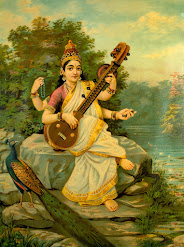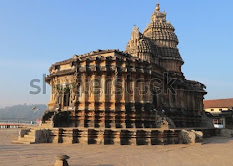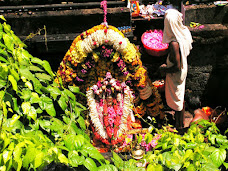 |
Saraswati painted by
Raja Ravi Verma, c 1930 |
Five thousand years back, a large group of horsemen appeared in India. They were a warrior tribe and travelled a long way from the plateau of central Asia. They crossed the Hindu Kush Mountains and the River Sindhu (Indus) to enter the plains of India. The journey continued further south until they settled in a fertile land watered by the mighty river Saraswati and its tributary Drishadwati. The serenity of this green land surrounded by blue water gradually made a big impact on their nature. Many of them gave up their fighter identity and devoted their energy in creation. Some from their group came out as writers who composed beautiful poetic verses dedicated to the gods and goddesses they worshipped. The land where they dwelled in came to be known as the Vedic state of Brahmavarta. They considered the River Saraswati an inspiration to their literary advancements. Like a mother, the river nourished them with food, drinking water and fresh air. Thus, she was called a revered mother goddess. The young boys and girls of the group sang the poetic verses to memorise them in order. Written scripts were yet to be developed, and memory was the only way to pass them over to next generations. As the River lent the sweet sounds of her ripples as accompaniment to those songs, she earned the hallowed status of the deity of literature, music and art. In due course of time with the change in climate, the River Saraswati dried up the Indian desert of Thar, but her cult somehow survived. The other gods of Vedic literature, Usha, Vayu, Varuna, Mitra and Aditi, were slowly forgotten, but Goddess Saraswati remained seated on an unbroken throne of time and knowledge. She also claimed the fifth new moon day in the 11th month of the Hindu calendar (Magha) as her day of worship. The day is still celebrated as Vasant Panchami or Saraswati Pooja by many Hindus across the world.
 |
| Saraswati, a lithography from Bengal |
Different images of this goddess are venerated in India. At some places she is believed to have four hands, and on some others she has only two hands like we have. In the Puranic tradition she is an incarnation of Goddess Durga and is called Maha-Saraswati to express her mystic power over the world. However, the local tradition has made her a beautiful and calm deity who represents knowledge, creativity and music. She blesses those who seek knowledge and skills in music and art. The common factor in all her forms is her choice of a colour – white. She is dressed in a pure white saree (sometimes golden bordered) and is seated on a fresh white lotus. A white swan, her preferred carrier, swims near her lotus. Religious interpreters say that white symbolizes her purity, true knowledge and wisdom. She also holds a musical instrument – Veena ‒ made of a tortoise shell. No other deity in Indian mythology openly exhibits her love for classical music, except Shiva who holds a small two-headed drum called Damaru which is used for rhythms during His celestial dance. Saraswati, though also worshipped by Indian dancers, does not show any prominent clue to her love for rhythmic body movements, except her anklets. She does not seem to be fond of chatting or socializing with other gods and goddesses. Perhaps this remotely gives hint of a learned woman who prefers the life of solitude.
Most probably that is the reason why temples of Saraswati are not so easily found in India. Devi Durga, Kali, Shiva, Vishnu, Krishna, Rama and others have their designated shrines in almost every village, town and city of the country. But Saraswati, though she is the oldest of all gods, is only offered prayer in a few places. We will look at them here.
1. Sharada Devi or Maihar Devi Temple, Madhya Pradesh
 |
| Maihar Devi Temple |
This temple of Goddess Sharada or Saraswati is located on a hillock called Trikooda, near the town of Maihar in Madhya Pradesh. The name Maihar Devi comes from the town which is famous for the temple of the goddess. This hilltop shrine was regularly visited by Ustad Allauddin Khan, the exponent of Indian classical music, who lived in Maihar for a long time and was the court musician of the local Maharaja. It is also believed that a body part of Goddess Sati, the consort of bereaved Shiva, fell in this spot and it became a holy site of worship.
2. Saraswati Temple, Rajasthan
The only temple of Lord Brahma, the celestial creator as well as the husband of Goddess Saraswati, is located in the town of Pushkar in Rajasthan. The Hindu system of belief considers divine couples as one entity and they are always worshipped in the same place together; sometimes in different temples, sometimes in one. Hence, along with Brahma, the goddess of learning gets a permanent shrine at Pushkar. Every year the place is flocked by tourists from different parts of the country.
3. Shringeri Sharadamba Temple, Karnataka
 |
| Shringeri Sharadamba Temple |
This old temple of Goddess Sharada (Saraswati) is located on the banks of River Tunga in the Chikkamagalur district of Karnataka. Adi Shankaracharya, the great Indian philosopher of the 8th century AD, founded this temple with a sandalwood idol of the goddess. It was later replaced with a golden effigy of Sri Shardamba by the rulers of Vijayanagara kingdom in the 14th century. It is believed that by worshiping Sri Shardamba in this temple, one can secure blessings of three gods ‒ Brahma, Vishnu, Shiva, and three goddesses ‒ Parvati, Lakshmi, Saraswati.
4. Panachikkadu Saraswathy Temple, Kerala
 |
| Panachikkadu Saraswathy Temple |
This old village temple in Kottayam district of Kerala is known as Dakshina Mookambi, as the idol of Saraswathy faces towards the south. A natural spring flows through the peaceful shrine and creepers grown in the spring embrace the idol as if to pay her respect. These tender plants are called by locals as Saraswathy leaves. The temple is believed to be guarded by a Yakshi (female spirit) and the exotic plants with their fragrant flowers. Many writers and artists of Kerala visit this temple as their holy pilgrimage. A ensemble of classical dance and music is held here during the nine nights of Navarathri festival.
5. Gnana Saraswati Temple, Telangana
 |
| Gnana Saraswati Temple |
This shrine stands on the banks of River Godavari at Basar, Telangana. Mythologically, it relates to a story of the Mahabharata. The composer of the epic, Veda Vyasa and his disciple Vishwamitra stayed in this peaceful riverside place after the Kurukshetra War. With the presence of two great sages, the area got sanctified. Later the temple was constructed near the confluence of the rivers Godavari and Manjira in the 6th century to remember its association with religious discourse and knowledge sharing. The holy temple is visited by children before they start their formal schooling. They devote books and stationery to the goddess in a ceremony known as Akshara Abhyasam.
6. Maa Saraswati Temple, Beluti, West Bengal
 |
| Maa Saraswati Temple, Beluti |
This temple is located in a small village named Beluti in the Birbhum district of West Bengal. The village makes a connection to the greatest Sanskrit playwright Kalidasa who was born in the 5th century. A folklore says that the littérateur was once an illiterate village lad and was insulted repeatedly by people including his wife. But he never gave up and offered his sincere prayer to Goddess Saraswati in this countryside. The goddess was so pleased with his devotion that the ignorant boy became one of the learned men of his time with her magical boon. The villagers worship six vermillion clad pebbles which are believed to be the seat of the goddess. On the day of Vasant Panchami people from nearby places flock to this shrine to seek the blessing of knowledge.
Acknowledgements
1. The Times of India
2. Scroll.in
3. Ananda Bazar Patrika
4. Pinterest.com
5. Shutterstock
6. worldhistory.org
7. nativeplanet.com










Great to know about the Shrines of Maa Saraswati 🙏
ReplyDeleteInsightful and informative 👌....keep enriching us more with your writing Subhdeep
ReplyDeleteInformative write-up, Suvadip. Jai Maa Saraswati.
ReplyDeletebah khoob bhalo...
ReplyDeletePlease pen down more such stories from our culture. I found it extremely engrossing Shubho da. (Muni)
ReplyDeleteThank you Subhodip. I didn’t know that out of few there is a Saraswati temple in West Bengal as well. - Prosenjit
ReplyDelete